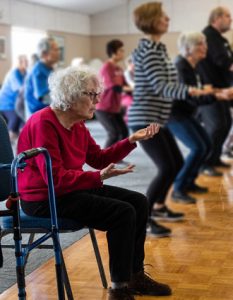Improve Balance and Exercise Capacity in Stroke Patients with Tai Chi
By John M. de Castro, Ph.D.
“With a complete focus on slow, controlled, and repetitive movements, tai chi is effective in improving one’s balance through dynamic motion and coordination, which is crucial to prevent falls. What many people may not know is that stroke survivors endure seven times as many falls each year as healthy adults.” – Henry Hoffman
Every year, more than 795,000 people in the United States have a stroke and it is the third leading cause of death, killing around 140,000 Americans each year. A stroke results from an interruption of the blood supply to the brain, depriving it of needed oxygen and nutrients. This can result in the death of brain cells and depending on the extent of the damage produce profound loss of function. Even after recovery from stroke patients can experience residual symptoms. Problems with balance and falling are very common. About 30% of stroke survivors develop spasticity, where the muscles become stiff, tighten up, and resist stretching. Obviously, spasticity can interfere with regaining movement after stroke.
The ancient mindful movement technique Tai Chi and Qigong are very safe forms of gentle exercise that appears to be beneficial for stroke victims including improving balance. Tai Chi involves both gentle exercise and mindfulness practice. Much has been learned. So, it makes sense to step back and summarize the research findings.
In today’s Research News article “The Influences of Tai Chi on Balance Function and Exercise Capacity among Stroke Patients: A Meta-Analysis.” (See summary below or view the full text of the study at: https://www.ncbi.nlm.nih.gov/pmc/articles/PMC7932789/ ) Zheng and colleagues review, summarize, and perform a meta-analysis of the published randomized controlled trials of the effectiveness of Tai Chi practice for the rehabilitation of stroke survivors. They identified 19 published randomized controlled trials.
They found that Tai Chi practice produced a significant improvement in balance. Standing and walking ability, 6-minute walking distance, gravity center swing, and exercise ability. Hence, the published randomized controlled trials make a strong case that Tai Chi practice is a safe and effective non-drug treatment to improve the balance and motor ability of stroke patients. These improvements should reduce the incidence of dangerous falls and improve the overall health and quality of life of these patients.
Tai Chi practice is not strenuous, involves slow gentle movements, and is safe, having no appreciable side effects, it is appropriate for all ages including the elderly and for individuals with illnesses that limit their activities or range of motion such as stroke. It can also be practiced without professional supervision and in groups making it inexpensive to deliver and fun to engage in. This makes Tai Chi practice an excellent means to help improve the balance and exercise capacity of stroke patients.
“Tai Chi has an overall beneficial effect on activities of daily living, balance, limb motor function, and walking ability among stroke survivors. . . and may also improve sleep quality, mood, mental health, and other motor function.” – Diyang Lyu
CMCS – Center for Mindfulness and Contemplative Studies
This and other Contemplative Studies posts are also available on Google+ https://plus.google.com/106784388191201299496/posts and on Twitter @MindfulResearch
Study Summary
Zheng, X., Wu, X., Liu, Z., Wang, J., Wang, K., Yin, J., & Wang, X. (2021). The Influences of Tai Chi on Balance Function and Exercise Capacity among Stroke Patients: A Meta-Analysis. Evidence-based complementary and alternative medicine : eCAM, 2021, 6636847. https://doi.org/10.1155/2021/6636847
Abstract
Objective
This study aims to explore the influences of Tai Chi on the balance function and exercise capacity among stroke patients.
Methods
Databases including PubMed, Embase, WOS (Web of Science), the Cochrane Library, CNKI (China National Knowledge Infrastructure), Wanfang Data, VIP (VIP database), and CBM (China Biology Medicine disc) were retrieved to gather the figures of randomized controlled trials on the balance function and exercise capacity among stroke patients. Then relevant data were input and analyzed in Review Manager 5.3.
Results
Nineteen papers were included and analyzed in this study. According to the combined effect size, the balance function of stroke patients improved significantly: the Berg Balance Function Scale score [MD = 7.67, 95% CI (3.44, 11.90)]; standing and walking test scores [MD = 3.42, 95% CI (4.22, −2.63)]; gravity swing area [MD = 0.79, 95% CI (1.48, 0.10)]; and gravity swing speed [MD = −5.43, 95% CI (−7.79, 3.08)]. In addition, the exercise capacity improved significantly as well: the FMA (Fugl-Meyer Assessment Scale) scale score [MD = 4.15, 95% CI (1.68, 6.63)]. There are no significant influences or changes of other related results.
Conclusions
Stroke patients are able to improve their balance functions and exercise capacities prominently when they do Tai Chi exercise once or twice a week and ≥5 times/week and >30 ≤ 60 min/time.
https://www.ncbi.nlm.nih.gov/pmc/articles/PMC7932789/
